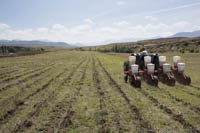Conservation Agriculture farming methods
There is general agreement that there are three basic principles that are used in conservation agriculture:
Minimal soil disturbance
Maintain a protective cover on the soil
Practice crop rotations
Following and understanding these principles are the basis for developing successful conservation agriculture systems, for both large-scale commercial farming operations and subsistence level systems common in many parts of Africa.
 Minimum Soil Disturbance
Minimum Soil Disturbance
Rather than disturbing all the soil in a field – typically down to a depth of 15cm (6 inches) as little soil as possible is disturbed. This is typically achieved by directly placing seed into a small slot formed in the soil with a no-till planter for mechanized operations, or jab planter or even a stick for small-holder farmers.
In modern day agriculture tillage operations (ploughing, disking, harrowing etc.) require a considerable amount of energy, different pieces of equipment and can have considerable negative effects on the soil structure.
 Maintain Soil Cover
Maintain Soil Cover
Soil erosion is the result of several natural and manmade factors. For the most part, things like rainfall (amount and intensity), the erodibility of the soil and the slope cannot be modified by farmers. Bare soil will erode much more than soil with crops or other plants growing on it. After crops have been harvested it is the non-harvested residue that can be laid on the surface of the soil to protect it during the time when there are no crops in the field.
The one thing that farmers can do to reduce is erosion is to protect it from the impact of falling raindrops. This can be done by maintaining an adequate soil cover, either with vegetation (cover crops) or residues from the previous crop.
Practices that remove residue after harvest (such as burning), should be avoided, or kept to a minimum.
Crop Rotations
Farmers have long known the value of crop rotations for keeping their soils productive and crops healthy.
Crop rotations often include growing crops from different plant families, and leguminous and non-leguminous plants in successive growing seasons. This helps to reduce the build up of soil pests and diseases that might accumulate between seasons when growing the same crop.
by Dr. Forbes Walker, University of Tennessee


